-
Wheelchair accessible
-
With kids
-
With pets
-
Architecture
-
Churches
-
Memorial Sites
-
Industrial heritage
-
Sculptures and Installations
-
Squares
-
Aizpute – Kazdanga
-
Priekule – Vaiņode
-
Castles and Manors
-
Pāvilosta – Ziemupe
-
Grobiņa – Durbe
-
Rucava – Nīca
-
Galleries and exhibitions
-
Music Theatre Cinema
-
Wheelchair accessible
-
With kids
-
With pets
-
Museums and expositions
-
Craftsmen and traditions
-
Creative workshops
-
Science and education
-
Aizpute – Kazdanga
-
Pāvilosta – Ziemupe
-
Rucava – Nīca
-
Grobiņa – Durbe
-
Priekule – Vaiņode
-
Indoor
-
Water attractions
-
With kids
-
Sports grounds
-
Wheelchair accessible
-
Outdoor
-
Strategic games
-
With pets
-
Picnic places
-
Winter activities
-
Paddling
-
Obstacle courses
-
On wheels
-
Fishing
-
Other activities
-
Windsport
-
Swimming areas
-
Walking trails
-
Aizpute – Kazdanga
-
Priekule – Vaiņode
-
Pāvilosta – Ziemupe
-
Rucava – Nīca
-
Grobiņa – Durbe
-
Horse Riding
-
Beach
-
Wheelchair accessible
-
With pets
-
Parks
-
Animals
-
Lakes and Rivers
-
With kids
-
Walking trails
-
Natur Objects
-
Rucava – Nīca
-
Priekule – Vaiņode
-
Grobiņa – Durbe
-
Pāvilosta – Ziemupe
-
Aizpute – Kazdanga
-
Decorative Gardens
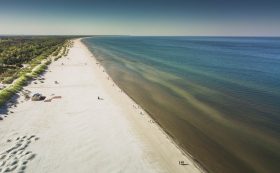
The Beach
Liepāja beach has been a popular swimming area since the 1860s when Liepāja was in the process of becoming a well-known spa resort and place to improve your health among European and Russian aristocrats, one of them being the Russian Tsar himself.

Concert hall "Great Amber"
The dream of a concert hall in Liepāja is more than a century old. The city council decided on the necessity of a concert hall in Liepāja at the end of the 19th century in 1896.

Holy Trinity Cathedral
Liepāja’s Holy Trinity Cathedral is located on Lielā Street in the centre of the old town. Construction of the Cathedral began in 1742 and consecrated in 1758. The construction was completed only in 1866, when according to the original plan the steeple had 2 floors added to it. In the spring of 2020, the reconstruction of the facade of the church building was completed
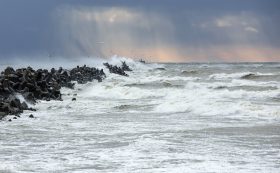
Northern Breakwater
The longest breakwater in Latvia – the Northern Breakwater – was built at the end of the 19th century as a crucial part of Liepāja’s fortress and military port. The breakwater is 1800 metres long and 7.35 metres wide. It is a favourite spot for locals to watch sunsets and go fishing in the sea. The views here are magnificent when nature shows its might in the stormy seas.
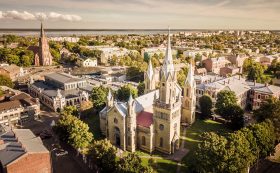
St. Joseph’s Cathedral
Liepāja’s St. Joseph’s Cathedral is the largest Catholic church in Kurzeme with a rich and ornate interior.
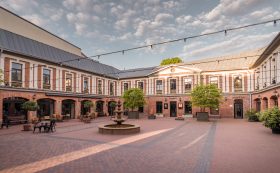
Courtyard "Romas dārzs"
The building was created in the 19th century as a shopping arcade with a spacious and romantic courtyard – typical in all European capitals of the time. It was later converted into a hotel.
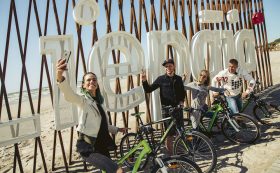
Environmental design object – letters "Liepāja"
After a great holiday in Liepāja, you cannot miss the selfie in your phone with Liepāja beach letters on the background.
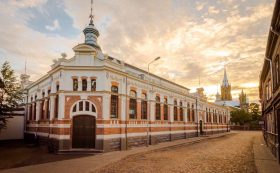
Peter’s Market (Pētertirgus)
Designed by architect Louis Melville in the style of Art Nouveau, Peter’s Market pavilion is one of the most beautiful market pavilions in Europe and was first opened in 1910. The architect’s job was not easy – designing a luxurious pavilion at the location of the former barracks in addition to being surrounded by three churches, St. Anne’s Church to the east, St. Joseph’s Cathedral to the west and a synagogue that was south of Peter’s Market before World War II when it was destroyed in July of 1941.

Environmental design object "The Tree of Ghosts"
The Tree of Ghosts is an environmental design object and a meeting place, built as a memorial for the rock band "Līvi" – this band of musicians was a symbol of their time and was part of creating the Latvian vision for the world. The Tree of Ghosts is an impressive 6-metre tall tree made from 4000 metal bars.
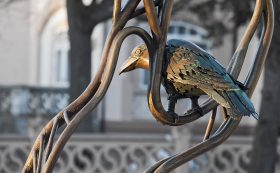
Sculptures of Liepāja Anthem Characters
Liepāja is known as the city of music, even having its own anthem "Pilsētā, kurā piedzimst vējš" (The city where the wind is born). The locally well-known characters of the anthem – a boatman, a crow, amber Latvians, and the human forest – have been recreated as bronze sculptures all along Kūrmājas Prospekts.
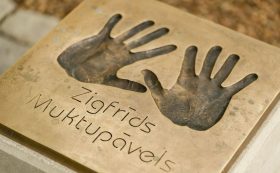
Alley of Fame of Latvian Musicians
Liepāja is the hometown of many beloved Latvian musicians – therefore it is the perfect location for the Alley of Fame, a place where anyone can compare their hand with the handprints of many prominent musicians in Latvia.
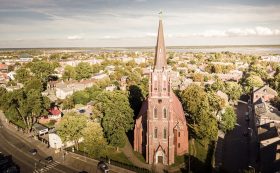
St. Annes Church
St. Anne’s Church is the oldest church building in Liepāja, first mentioned in written records in 1508. It was originally a wooden building, but over the years both the nave and the steeple have been reconstructed several times.
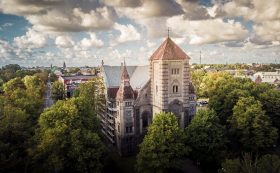
Luther’s Church
Liepāja’s Luther’s Church is the largest church constructed during Latvia’s independence years. Construction began in 1914 and it was built in the shape of a cross from stones quarried in Finland.
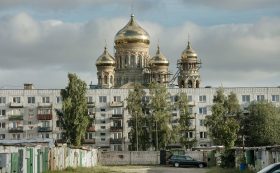
St. Nicholas Russian Orthodox Naval Cathedral
The St. Nicholas Russian Orthodox Naval Cathedral is the dominant visual and spiritual feature of Karosta sharply contrasting with the surrounding panel apartment blocks.
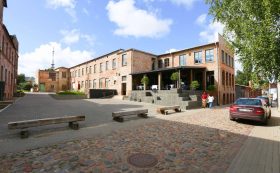
Julianna’s Courtyard
Thanks to several new entrepreneurs, these historical manufacturing buildings, where the Keten printing house, sandal factory and a sewing workshop were once located, have now become an attractive example of industrial architecture and lofts. The surrounding buildings presently house a restaurant, a café, a beer cellar, a bar, and several creative businesses.
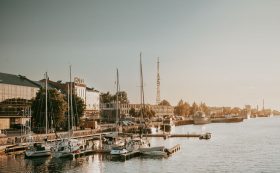
Old embankment Promenade
During the Soviet era, the Promenade was a closed military territory all the way from the Tram Bridge to the sea. It is currently a place for a peaceful stroll as well as a vibrant night life, an attractive place to relax with rock and roll and to have business meetings with an artistic touch.

Square of Roses
The Square of Roses is the heart of the city and its main gathering spot. As its name reveals, the unchanging feature of this square is the roses that have regularly been planted here for over a hundred years. First to bloom in spring are the crocuses, followed by daffodils and tulips. Summer is when the gorgeous roses are in full bloom. During winter the square becomes a romantic Christmas island.
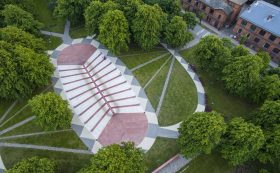
Jānis Čakste Square
This wide space was originally used for the training of soldiers and their parades. Trees were planted here only at the beginning of the 20th century. On the 300th anniversary of Liepāja in 1925, the president of Latvia Jānis Čakste, along with several other heads of the city and the nation, planted a linden tree in each corner. The square is named after the first president of Latvia – Jānis Čakste – in honour of this event.

Southern Breakwater
The Southern Breakwater lies north of Liepāja’s central beach and is crucial in protecting the Port of Liepāja. To get to it, it is best to go on a leisurely walk along the beach. Car parking is available in the parking lot on Kūrmājas Prospekts or at the end of Roņu Street.
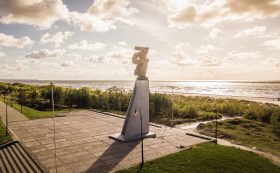
Monument in commemoration of the perished fishermen and seafarers
At the end of Kūrmājas Prospekts in the Seaside Park is a monument in commemoration of the perished fishermen and seafarers – a statue of a woman looking into the distance toward the sea, waiting for sailors who have not returned.
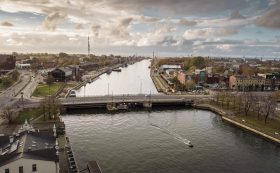
The Trade Canal
The Trade Canal is 3 km long, connecting the Baltic Sea with Lake Liepāja and separating Vecliepāja (Old Liepāja) from Jaunliepāja (New Liepāja). Excavation of the canal began in 1697 with the intended purpose of creating a new port because the river Līva that used to run through Liepāja and once functioned as a port had become clogged.
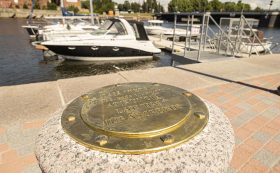
Inscribed plaque commemorating the restoration of the Latvian Navy in 1992
Memorial sign at the bollard in the port of Liepāja, marking the location of the symbolic restoration of the Latvian Navy 30 years ago, on 11 April 1992.
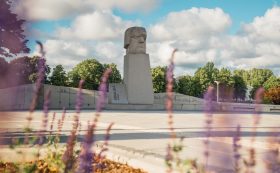
Monument to Kārlis Zāle
In 1989, on the occasion of sculptor Kārlis Zāle's 100th birthday, the city of Liepāja announced a competition for the design of a monument dedicated to the artist. The proposal by sculptor Bruno Strautiņš and architect Edgars Krūmiņš won first place in this competition.
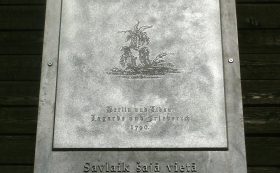
Memorial sign plate for German philosopher Immanuel Kant
On the corner of Bāriņu and Dārza Streets there used to be a private printing house, where Immanuel Kant’s famous “Critique of Pure Reason” was printed in 1790.
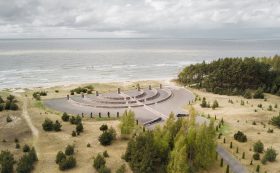
Memorial to the Holocaust Victims and "The Righteous Among the Nations" Alley
The memorial is dedicated to the more than 3000 Liepāja Jews killed in World War II and is the largest memorial to holocaust victims in Latvia. It is in the shape of Israel’s national symbol – the menorah or the seven-branch lampstand. Its contour is clearly visible from a birds-eye view and is made of split boulders and granite blocks.
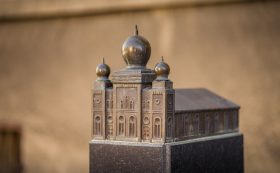
Memorial site to the Liepāja Great Choral Synagogue
Until the Second World War, Liepāja was a home to 12 synagogues and prayer halls. The most notable was the Great Choral Synagogue.
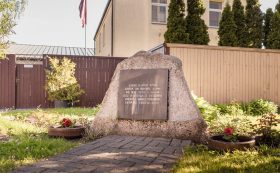
Liepāja Jewish ghetto Memorial stone
Liepāja Jewish ghetto was set up on July 1, 1942, and all Liepāja residents of Jewish nationality were ordered to move to the closed ghetto territory located in between Dārza, Apšu, Kungu and Bāriņu streets, forbidding them to leave it without permission, whereas the local population was not allowed to enter it or maintain contacts with ghetto people. About 800 people, who survived after the 1941 massacres lived on the territory of the ghetto. The ghetto was overcrowded, living conditions were harsh, and the daily food ration was insufficient.

The memorial plaque at the lighthouse
A memorial plaque near the lighthouse was erected in memory of the first victims of the massacres of Jews that took place in Liepāja during the Nazi occupation.
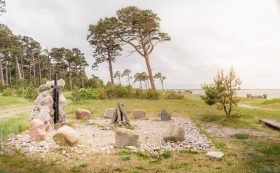
Memorial to the Kurelians
The Kurelians (Kurelieši) were a Latvian unit of soldiers led by General Jānis Kurelis, which was formed in July 1944 on permission from the German occupation authorities to fight against the Soviet Army. The real purpose of the unit was to fight against both occupying powers – Nazi Germany and the Soviet Union – in the hope of restoring an independent Latvia.
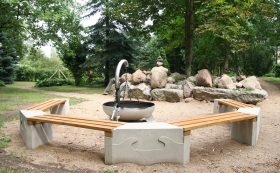
Ģirts Brumsons' Park of Art
A nature park with a collection of rare plants and the artwork and small architectural forms made by Ģirts Brumsons.
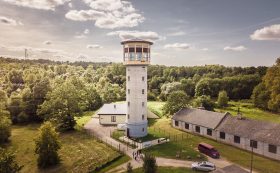
Aizpute Water Tower – The Observation Tower
The 27 m high water tower was built in 1960 and functioned until 2009. The first storey of the building is available for viewing, valves of the water supply network are on display, and there is also information on other industrial objects in Aizpute. There is also a working 3D model of the water tower and borehole. There is a great view of Aizpute’s buildings from the tower.
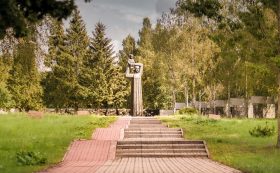
Priekule Memorial Ensemble of Warrior’s Cemetery
The largest cemetery in the Baltics for soldiers fallen in World War II, where more than 23,000 soviet soldiers have been buried. The military operation "Priekule" was one of the fiercest and lethal fights of the Kurzeme Pocket between October 1944 and the February 1945. During the battles the front line moved over the region 7 times. After the World War II there were only a few dozen houses left in Priekule.
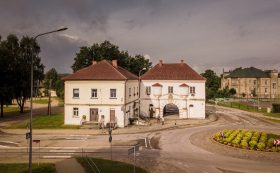
Priekule Manor Complex
The complex consists of the Swedish Gate, Priekule Manor building and the manor viewing tower. Korff barons ruled in Priekule since the 15th century. At that time the manor itself and the manor fortifications were built to defend against pillagers.
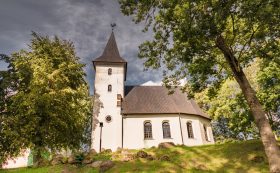
Priekule Lutheran Church
This comparatively small stone church was built in about 1680 on a hillock on a road leading to Priekule manor. During World War II the church was completely destroyed, like the most of the city. The church was restored during 1995 through 1998. The altar, interior design and wood carvings are made by the students of Riga Crafts School.
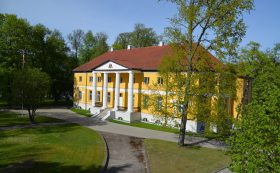
Vērgale manor house complex
The manor complex was built in the 18th century, but was later rebuilt in the late classicism style. Now it is home to Vērgale Primary School, library, culture centre and the local administration. Vērgale Local History Museum is located in the former distillery. One of the biggest mantel chimneys in Kurzeme has remained in

Durbe Lutheran Church
It was built in 1651 and is the oldest building in the town. The church is included in the Latvian national list of protected monuments. A boulder fence around the church has survived till today.
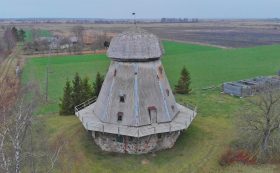
Prenclavu Windmill
One of the biggest windmills in Latvia – with four grinding sections, which provides vast grinding opportunities. Mill and its machinery is maintained in its original appearance.
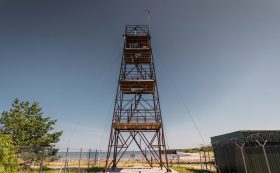
Former army tower – a viewing platform
The tower is equipped with fixed binoculars, from which both ships at sea and birds on the beach can be observed.
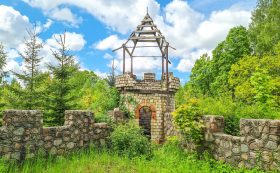
Paplaka Disneyland
"Paplaka Disneyland", as locals in Virga municipality call it, may be the most unusual playground in Latvia – a brick-built medieval fortress in miniature with turrets, underground passages and bridges. It is located on the territory of the former military garrison; the playground was built for the kids of Soviet soldiers.

Bakūzes Manor
Bakūze Manor was first mentioned in written records as early as 1486. Today, you can have a look at the manor’s interior, explore an exhibition of porcelain dishes, enjoy historical tales about the manor, see an ancient Curonian amulet from the 15th century – a bear’s claw, a grain grinding stone, and an ancient stone staircase. You can hike through the sacred places of Embūte, in particular energy filled sites, which have remained of importance to the Embūte locals throughout the ages. We can give you a guided tour of the history of Embūte and the surrounding area. Contact us at +37126199518 in advance to arrange a guided tour. In addition, you can sip tea or coffee from the Rīga Porcelain Factory’s crockery. It is possible to arrange lunch or dinner at Bakūze Manor in cooperation with the caterer. There is a sauna and hot tub, a swimming pool and a fishing pond nearby. By prior arrangement, you can also taste various herbs and vegetables at the local producer ”Embūtes garšaugi”.
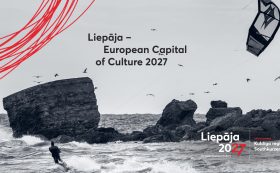
Liepāja - European Capital of Culture 2027
There are sophisticated and powerful cultural traditions, extensive and diverse contemporary entertainment opportunities in Liepāja, high-quality and comprehensive cultural offer, artists performing from all over the world, and broad option choice for everyone to engage in shaping and developing Liepāja cultural life.

Concert hall "Great Amber"
The dream of a concert hall in Liepāja is more than a century old. The city council decided on the necessity of a concert hall in Liepāja at the end of the 19th century in 1896.
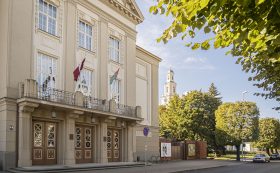
Liepāja Theatre
The oldest professional Latvian theatre in Latvia with an excellent troupe. Not only great all-age artistic performances and awardwinning plays, but also tours behind the stage. Many say – the most beautiful theatre in Latvia!

Art gallery "Romas dārzs"
The Gallery "Romas Dārzs" combines a gallery with an exhibition hall in the underground tunnels of the building.
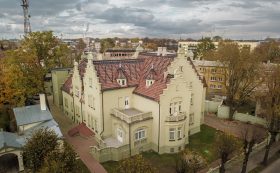
Liepāja Museum
Liepāja Museum has a very important role in preserving and popularizing the national cultural heritage of Latvia. This is the place where the history of Liepāja meets new and recent developments in the world of art.

Liepaja Occupation Museum
The Liepāja Museum’s branch “Liepāja Occupation Museum” was opened on January 21, 2001. Its mission is to preserve the nation’s collective historical memory to strengthen national self-awareness, which serves as the ideological and emotional foundation of statehood, and to provide insight into the history of lost independence and foreign occupation. The branch is located in a building that, during the Latvian National Awakening (Atmoda), housed the Liepāja branch of the Latvian Popular Front.
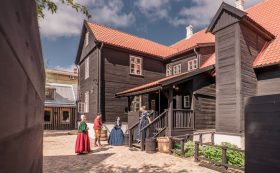
17th-19th century interior museum "Madame Hoyer's Guest House"
The guest house of the meat sorter David Hoyer's widow Margarethe Gertrude Hoyer, or the 17th – 19th century interior museum is a success story of how an important architectural landmark of national importance, an element of Liepāja's cultural heritage, is witnessing its renaissance and is now open to the public in the open museum format.
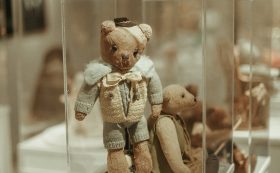
Museum of Puppet Art and Design
The Puppet Art and Design Museum is located in the "Romas dārzs" gallery. The main exhibition of the museum reflects the history of dolls, toys and household items of the 19th and 20th centuries. In addition, it has three exhibition halls where contemporary art is exhibited, as well as exhibitions dedicated to design. The smallest exhibition space in Liepāja called "Mākslas ala" is special, where the creators of the museum offer to hold a solo exhibition of one work of art for both budding and professional artists.
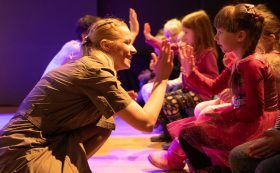
Liepāja Puppet Theatre
Contemporary and classical puppet theatre performances. Exciting tours about the history of the doll making and the secrets of the puppet master profession, participating in the creation of a puppet show.
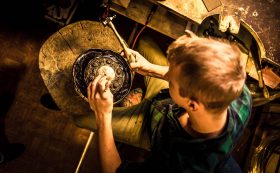
The House of Craftsmen
16 craftsmen of the Kurzeme region gather here at the House of Craftsmen. They are more than happy to tell visitors about their craft and traditions. Their workshops are located on two floors of the building. Visitors can see the process of creating a national costume on a loom, the making of silver jewellery, ceramic art and wickerwork, creations from leather and amber.

Cultural space "Tipogrāfijas radošais kvartāls"
The cultural space "Tipogrāfijas radošais kvartāls" is located in the historic Liepāja printing house, built in 1890, which is being reborn as a centre for art, music, and creative industries. You can enjoy concerts, events, delicious drinks, and relax while playing board games in the courtyard. This is where talent, ideas, and entertainment come together, creating an inspiring environment for creative synergy and togetherness.
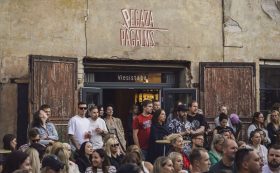
Cultural space "Pegaza pagalms"
The cultural space "Pegaza Pagalms" is a vibrant hub in Liepāja that, since 2022, has become one of the city’s most dynamic meeting places, offering a wide range of events for both residents and visitors. Each week, the venue hosts 2 to 4 cultural events, bringing together art and entertainment enthusiasts from various genres.
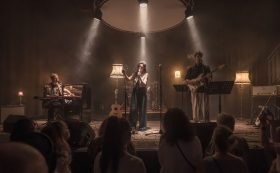
Culture House "Wiktorija"
The Culture House "Wiktorija" is a place where music, cinema, theatre, and other artistic experiences blend in harmonious interplay. It embodies the independent spirit of Liepāja, reflected in the people who fill the house, the events that inspire, the distinctive interior, and the enchanting summer concert garden.
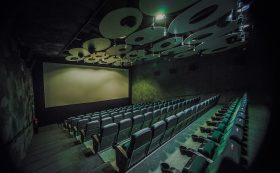
Movie theatre "Cinamon Liepaja Balle"
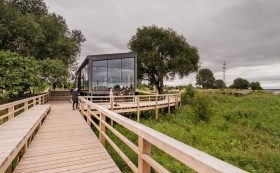
Nature House
Nature House is a modern nature and environmental education centre located on Zirgu Island in Lake Liepāja. It is one of the three locations of the Science and Education Innovation Centre, where everyone is invited to explore the natural world creatively and excitingly.
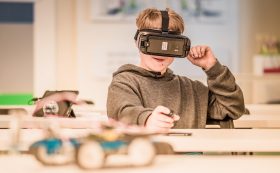
Science and Education Innovation Centre "STEM House"
The Science and Education Innovation Centre "STEM House" offers interactive exhibitions where visitors can explore various technologies and delve into the laws of nature. These exhibitions aim to spark curiosity, encourage inquiry, foster understanding, and inspire the joy of discovery. The centre is open to all who are interested, especially families with children and school groups.
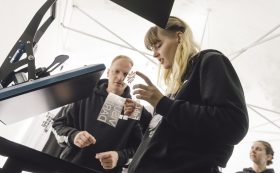
Digital Production Laboratory "FabLab Liepāja"
"FabLab Liepāja" is a multifunctional manufacturing laboratory that offers the opportunity for everyone, regardless of age or previous experience, to explore digital technology and creative production. This laboratory is open to all who want to learn more about 3D printing, computer graphics, electronics prototyping, and much more.
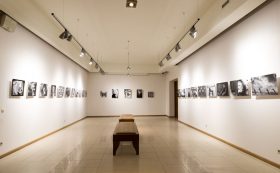
Liepāja Latvian Society House Art Gallery
Exhibitions by artists from Liepāja and the rest of Latvia can regularly be seen in the gallery and in the foyer. These exhibitions aim to strengthen the Latvian identity.
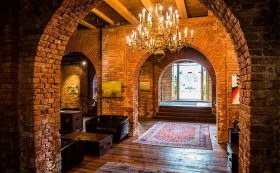
Art Gallery "Promenade"
The lobby of "Promenade Hotel" may seem a bit unusual as it contains a whole art gallery. Notable Latvian painters have their solo exhibitions on display here. There are also display cases with the works of Latvian craftsmen and jewellery artisans available for viewing and purchase. The items on display are made of silver, amber, pearls, glass and linen.
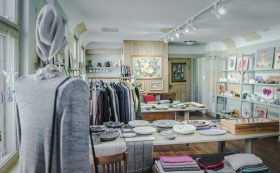
Art shop – gallery "Ludviķis"
The artists Inga Kleina and Aivars Kleins are behind the idea and implementation of this art shop and gallery where you can view and purchase artwork – paintings, bijou, ceramics, textile and wooden design items – that is made by different artists from Liepāja, Latvia, and the Baltics and is useful in daily life. In the basement, visitors can have a look at the art exhibitions.

Art Gallery and Studio "Elis.Artworks"
Art Gallery and Studio “Elis.Artworks” invites you to view and purchase paintings, art souvenirs, design objects, lifestyle items, and unique gifts.
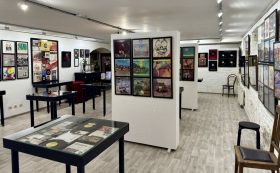
Music gallery "Vinilkoks"
The owner of the music gallery "Vinilkoks", Raitis Pavlovičs, is a vinyl record enthusiast and collector. His collection features a wide range of records released by both Latvian and international musicians. One of the most extensive collections includes the works of composer Raimonds Pauls, currently comprising over 330 records featuring Raimonds Pauls' music and his participation in recordings. These records have been released in Latvia, the USA, Australia, Japan, Canada, Sweden, Germany, and other countries from 1956 to the present day.
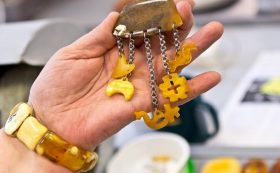
Centre of Applied Arts "Dārza iela"
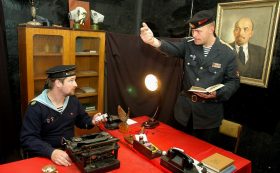
Karosta Prison Museum
An unusual museum awaits visitors in Karosta. It is a real prison that practically has not changed since the times of the Tsar. You can see the layout of the cells, experience what it felt like as a prisoner in solitary confinement and find out about the history of different time periods and their ruling powers.

Creative studio "Samts"
The creative studio "Samts" organizes creative workshops and masterclasses for children and adults.

Candle workshop "Sun Candles"
Join the "Sun Candles" workshop to learn the art of making candles in a creative and supportive environment under the guidance of experienced masters. You will learn various candle-making techniques and materials and have the opportunity to craft unique candles or aroma diffusers that reflect your vision and emotions.
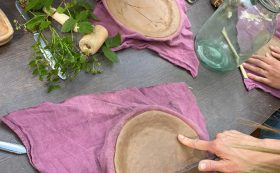
Pottery workshop "Story of a Potter"
Clay workshop allows you to feel like a real potter. Together with an experienced potter, you will go back in time and unfold the story of Liepāja pottery, awakening your imagination to create your own black clay crock. The clay workshop will become an exciting adventure for both adults and children. Participants over 6 years old make their own pottery pot (participants younger than 6 years old make their own pot from clay material that they can take away immediately). The pottery made during the workshop is taken to the authentic kiln, built according to ancient tradition using the firing technique, and then sent to the participants via courier post (parcel machine).

Austra's room
A bustling place of culture for attending concerts by folk singers and meeting poets. This creative space was created in honor of the legendary Latvian folk singer Austra Pumpure.
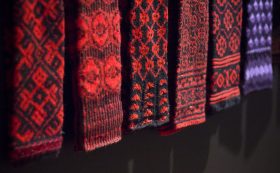
Kurzeme national costume information centre

Folklore centre "Namīns"
Celebration of Latvian annual traditions, experiencing ancient customs and folk dances. Educational and cultural programmes include singing of folk-songs, dancing and having a meal cooked in a large soup pot.
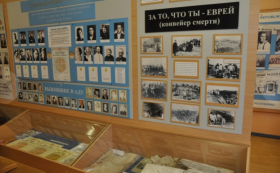
Museum of Liepāja Jewish Community’s History
The exhibition is divided into three historical time periods. The first is the period lasting until World War II when there was a large Jewish community in Liepāja. The second part commemorates those who died in the World War II holocaust. The third part of the exhibition covers the time from May of 1945 until present time.

Environmental design object "The Tree of Ghosts"
"The Tree of Ghosts" is an environmental design object and a meeting place, built as a memorial for the rock band "Līvi" – this band of musicians was a symbol of their time and was part of creating the Latvian vision for the world. "The Tree of Ghosts" is an impressive 6-metre tall tree made from 4000 metal bars. The names of the most popular "Līvi" songs can be seen on the bricks laid around the tree and the contours of 5 different musical instruments are hidden in the branches.

Alley of Fame of Latvian Musicians
Liepāja is the hometown of many beloved Latvian musicians – therefore it is the perfect location for the Alley of Fame, a place where anyone can compare their hand with the handprints of many prominent musicians in Latvia.

Sculptures of Liepāja Anthem Characters
Liepāja is known as the city of music, even having its own anthem “Pilsētā, kurā piedzimst vējš” (The city where the wind is born). The locally well-known characters of the anthem – a boatman, a crow, amber Latvians, and the human forest – have been recreated as bronze sculptures all along Kūrmājas Prospekts.
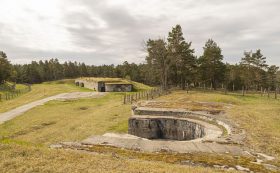
The historical exposition of the Latvian War Museum Liepāja’s coastal artillery battery No. 2
Among the objects of Karosta, Liepāja’s coastal artillery battery No. 2, is still the most mysterious place in Liepāja.
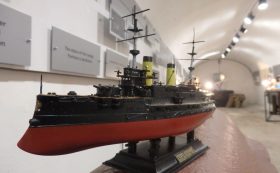
Karosta and Independence War Museum
The museum features several exhibitions. One of them tells about the origin, construction and history of the Karosta. The exhibition is based on a time line, which marks the main events in the history of the Karosta from its origins to the present day. The time line is complete with objects corresponding to the periods. Interestingly, most of the objects on display were found in the Karosta.
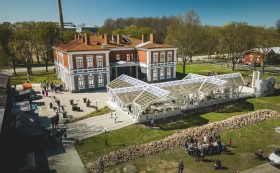
Cultural space "Atmodas Dārzs"
A venue for concerts and events with a good atmosphere, a relaxing and artistic environment, a spacious garden and a cafe.
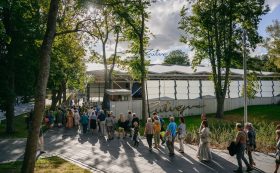
Open-air Concert garden "Pūt, vējiņi!"
The origins of "Pūt, vējiņi!" can be traced back to the late 19th century, specifically in the 1870s under the direction of the famous architect Paul Max Bertschy, who initiated the construction of the first concert stage in Liepāja as part of the resort complex. This stage, featuring a small platform, was inaugurated in 1875. It became a beloved cultural enjoyment and recreation spot for many city spa visitors, as well as the residents themselves.

Auto exposition
At the museum, one can learn about the last 100 years of automotive history, see several historical automobiles and look at some unique photos. The exhibition consists of several trucks, military transport units, and several rare sports cars.
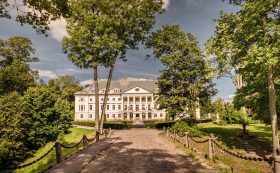
Kazdanga Museum
Kazdanga Museum is set in the Kazdanga castle. It was built at the beginning of the 19th century and was owned by very rich and politically influential barons of Courland – the Manteuffels. The Kazdanga castle is still considered as one of the most exquisite samples of the classicism in Kurzeme. Its design and planning bear resemblance to the Mežotne castle.

Apriķi Museum
The museum is set up in Apriķi Manor, the baroque ensemble of which is built in the early 18th century. The museum tells a history of the county. A separate exposition is created to tell about of the residents of this manor, Gustav Mannerheim, who later became a president of Finland.
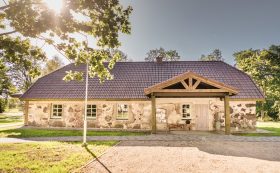
The artefact storage "Jūras māja" (Marine house)
In the former dairy building, there are expositions of the history of Ziemupe and various exhibitions. A tourism information centre is also located in the building, with the possibility of using a shower and washing machine.
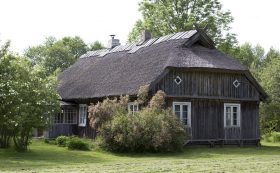
Open-air Museum "Vītolnieki"
It is a branch of the Latvian ethnographical open-air museum and features a typical farm of a coastal village where people used to be engaged both in fishing and farming. Old trees surround the domestic house with a reed roof thatched in the manner characteristic of this area. The house has a veranda with windows and ornamented door jams. Inside you can see old wooden furniture and different household items from previous generations.

Pāvilosta Local History Museum complex
The museum is a proud owner of unique forged bronze brooches and belts found in Saka County. However, those are only a small part of the whole 10,000 piece collection of stocks. In addition to the permanent exhibition, there is a special section with fossils and amber found in the region.
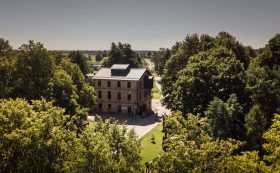
Exposition of antiquities "Centra dzirnavas" (The Central Mill)
Mill in the center of Rucava was built in 1937 and operated by its primary purpose up until the sixties, being an important location for the grain processing in the Rucava County (Paurupe back then). It was also called a "castle of lights" as electricity, produced by steam locomotive to operate the mill, was enough to provide light also to the part of Paurupe village. In subsequent years, the building was used as a warehouse for mechanical workshops, which operated until the nineties.

Nīca Exposition of Antiques
Here you can see more than a century old Nīca folk costumes. Also you can find all about Nīca: old traditions of handicraft mintage viewed Nica-woven blankets, towels, table cloths, a variety of embroidery, and knitwear - gloves, socks etc. Collection of ancient household items, tools and books. There you can find an interesting information about county's history.
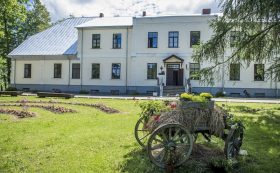
Aizpute Local History Museum
Exhibits about the history of Aizpute over the centuries, about Liepāja-Aizpute and Aizpute-Saldus narrow-gauge railways, schooling, crafts and other activities.
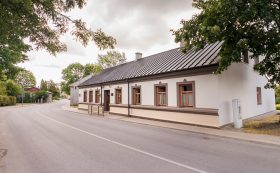
Memorial Rooms of Zenta Mauriņa
Zenta Mauriņa (1897-1978), an outstanding philosopher, renowned translator, writer and winner of international awards lived here since 1898 till 1921.

House of tradition "Zvanītāji"
The ethnographic house “Zvanītāji” is a wooden house built at the end of the 19th century, which has still retained its original appearance. In 2000 the house was turned into a museum and equipped with household items typical of a late 19th century. The exposition displays Rucava folk costume, mittens, socks and other hand made works. By prior appointment Cultural/ educational programmes are offered to tourist groups. Programmes include singing of folksongs and dancing together with Rucava narrators and singers as well as tasting traditional Rucava food like local rye-bread, carrot cakes, white butter with potatoes and little loaves of potatoes.
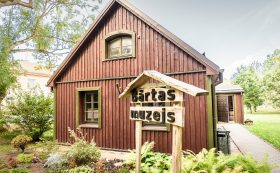
Bārta Museum
The permanent exhibition of the Bārta Museum tells about the making and wearing traditions of Bārta national costume. Visitors are involved in the embroidery of samples and the weaving of handkerchiefs. Exhibitions are regularly organized in the museum, too.
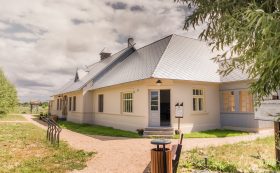
"Dzintarvēji"
The old fish drop-off and processing station, or a fishery, has become Pape's information point, which also covers expositions of fishing tools and the history of Pape and Nida village.
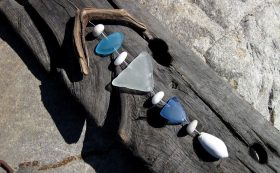
Ornament workshop "Jūras rotas"
Inspired by Pāvilosta! Non-ornamented bijou and design items. Natural shapes. Earrings, rings, various pendants, marine souvenirs, wooden and stone charmers or monsters, wind bells, aurora glow caught in glass, garland stones and more.
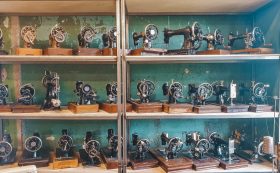
Private collection of sewing machines
The private collection covers more than 200 sewing machines from different countries, from pre-war years to Soviet time manufacture. The host provides enthusiastic stories of nearly every sewing machine.
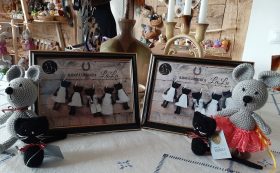
Creative workshop "LaLu"
The artisan person Laila Luzere creates hats, scarves, gloves, jewellery and other things with her own hands, working in various techniques. Her creative studio "LaLu" is full of toys that delights children and adults alike. There are also old items whose background history and aura are in harmony with the works of the artist.
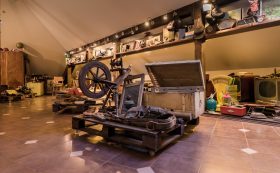
Underestimated things museum in the landfill "Ķīvītes"
In the museum one can view ancient household items, unique and valuable things that were found in piles of waste. At the exhibition a historical spinning wheel, a dowry chest, a ladies’ toilet locker dating back to the 19th century can be seen alongside sewing machines of different periods, appliances and many other interesting household items. A massive original portrait of Lenin painted in 1960 in a gilded frame and Liv artist Jānis Belte’s painting should be especially pointed out.
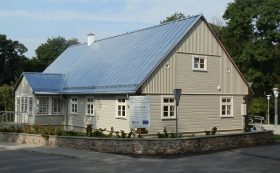
Durbe Museum
The museum is located in the former home of Z. A. Meierovics, the first Minister of Foreign Affairs of the Republic of Latvia. It has permanent and temporary expositions dedicated to the well-known people who had been related to Durbe and educating about the local history.
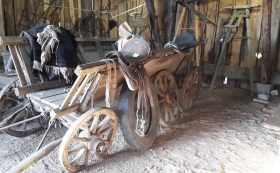
Antique horse tack shed of Otaņķi Antiques Storage
Behind the elementary school in Rude, there is a barn of old harnesses, where you can see the harnesses donated to the storage, learn about their use and the horse care customs of the Otaņki side. Everything can be touched, even climbed and tried, that is our belief. Getting to know new places and feeling history is always exciting! We look forward to visiting young and old! Please book your visit in advance!
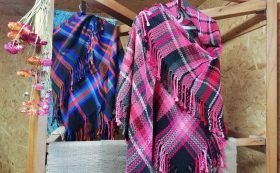
Workshop of weaver Agra Vaitkus
Here visitors can follow the process of creating a wool blanket, shoulder scarf, sauna towel and other linen products, as well as try their hand at weaving.
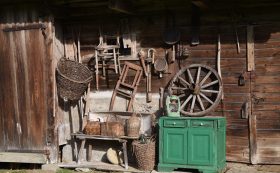
Exposition of Antiques in Rural Homestead "Galdnieki"
Exposition of the artefacts related to the history of Nīca and Pērkone.
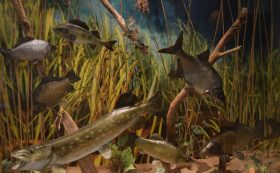
Lake Durbe Exhibition
An informative and educational exhibition on Lake Durbe from the Ice Age to the present day. There are models of the fish that live in the lake and interactive exhibits on the formation of the lake, historical records and reasons for the lake’s eutrophication.
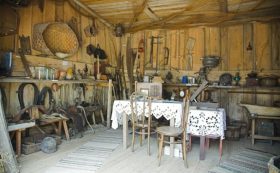
Jūrmalciems Exposition of Antiques
The village of Jūrmalciems lies on the seacoast and is noteworthy due to it distinctive and ancient environment. Fishing is still an occupation for a number of local people. The most frequented site in Jūrmalciems is the sea and its breakwater, which still serves as a pier for fishing boats. You can learn more about the history of the village in the exposition “Ancient times of Jūrmalciems people” (“Jūrmalnieku senatne”). It displays household items, tools used in fishery and forestry, and photos.

Exposition of antiques "Lauksargi"
Visits by prior arrangement!

Rogas Family Private Collection
Collection of presentation pens, exposition devoted to the subject of firefighting and motorcycles.
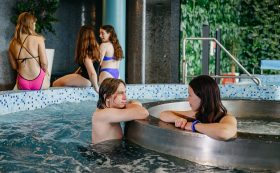
LOC Pool & Spa
The biggest and most modern pool at the SPA centre in Kurzeme region. The SPA complex includes different types of water attractions for children, as well as recreation and relaxation opportunities for adults. After the activities in water, visitors have the opportunity to try three different types of saunas (salt sauna, Turkish bath and aroma bath) as well as different types of massage pools. While relaxing in the SPA area, visitors can quench their thirst with a healthy, freshly squeezed juice at the Tropical cocktail bar.

LOC Olympic Centre
A universal sports and health complex. Opportunity to engage in fitness, swimming, basketball and other types of sports both individually and in groups.

LOC Tennis Hall
The LOC Tennis Hall has an area of 5,988 m² and offers five indoor tennis courts with a hard surface and a dedicated warm-up area. The fitness hall is equipped with the latest generation of exercise and training equipment. The White Hall is adapted for TRX suspension systems, trapeze, and free movement, making it suitable for group and individual training. It can also be used as a conference hall or as a players’ lounge during tennis competitions. The Red Hall is intended for small group training, meetings, small conferences, and corporate events.
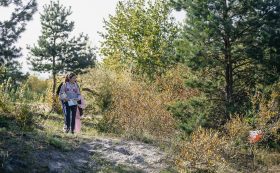
Orienteering ground in the Seaside Park
The three-kilometre long Seaside Park is 50 hectares wide and is one of the largest planted parks in Latvia. From the very start, the park was and still is a popular recreation place.
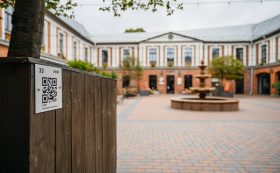
Orienteering ground in the Centre of Liepāja
The orienteering route or ground is located within the Liepāja city and consists of many control sites that are actual popular tourism places. You are free to make your own route, as navigation between control sites is not specified.

Orienteering ground in Karosta
Karosta is the largest historical military territory in the Baltic and accounts for nearly one-third of the total Liepāja city administrative territory. The orienteering ground created in Karosta will help you to learn more about this part of the city.
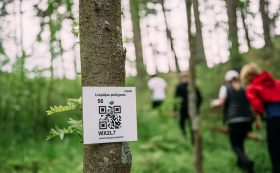
Orienteering ground in Beberliņi
The orienteering ground is located near Beberliņi Lake with a diverse landscape: pine forest, dunes, military objects and catchy terrain. QR code plates are located at checkpoint locations, while the result can be marked with "Qrenteering" mobile application.
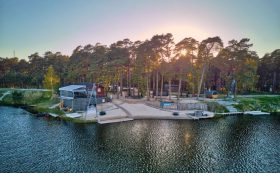
Active leisure park "BB wakepark"
BB Wakepark is an active recreation park in Karosta, near the Beberliņi reservoir, where you can enjoy the fresh pine forest air and picturesque views of Beberliņi’s white sand dunes all year round.

Recreation complex "Austrumu forti"
Austrumu forti is a recreation complex located on a well-maintained island near the city limits in the direction of Riga. The area is ideal for holidays with family or friends, as well as for various events – birthday parties, weddings, bachelor/bachelorette parties, and corporate gatherings.

Adventure park "Tarzāns"
Eight obstacle routes both for children (3 routes) and adults (5 routes) including the 330 meters long slide across the whole water pit Beberliņi.

A trip to the sea and fish degustation
A historic fishing ship with a crew invites you to visit on board the ship and on trips along the Baltic Sea coast.
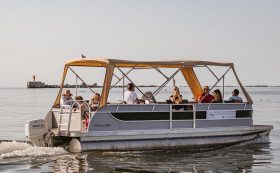
Trips to the harbour waters with the "Water Sledge"
A boat trip round the Liepāja harbour, along the breakwaters, observing there the presence of different birds, and a view of the O. Kalpaka Swing Bridge.
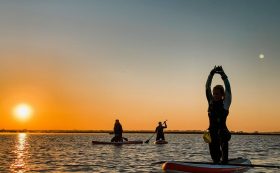
Liepaja SUP school
We offer training in paddling with an SUP board. Trips, descents, sunrise on the water, paddling at sunset. We can plan shorter or longer trips, for larger and smaller groups. Being on water, spending quality free time, very well develops muscles and a sense of balance. Sport is available to everyone; main condition is presence of water. Easy to paddle in rivers and lakes to see the surroundings from a completely different point of view.
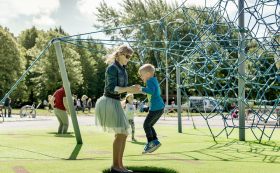
Children playground in Seaside Park
For various ages.
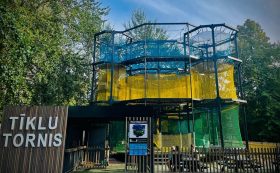
Net Tower
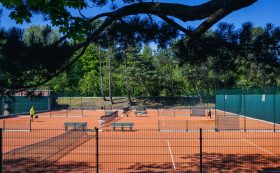
LOC Tennis courts
Seven open-type tennis courts with a "clay" surface and a warm-up wall are available. For the convenience of visitors, an information centre and changing rooms are available.
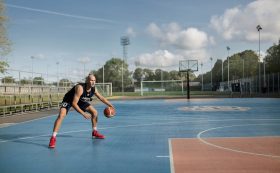
Kristaps Porziņģis basketball courts
These basketball courts equipped with lighting were gifted by Kristaps Porziņģis’ family and built according to NBA parameters. An outdoor gym and an exercise area are located next to the court in the Seaside Park.
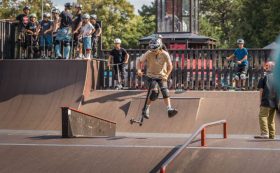
Outside skate park
Extremely popular among teens, especially in summer months, gathering together BMX riders, roller skaters, skateboarders.
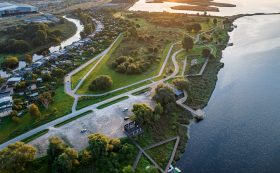
Roller-skating and cycling track on Zirgu Island
After taking just a few minutes walk from the city’s heart active enthusiasts can enjoy 1.2 km long roller-skating and cycling road.

Trips to the harbour waters
Boat trips to the port waters, individually or for groups up to 15 persons.
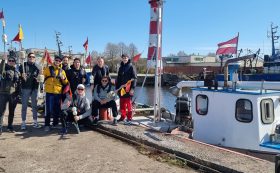
Coastal fishing experience with fishing vessel
Those who are keen to learn more about the angler skills are offered to take a ride on a fishing vessel called "Balta". Setting up and pulling nets, onboard grilling the daily catch. The activity is available to groups of up to 10 persons.
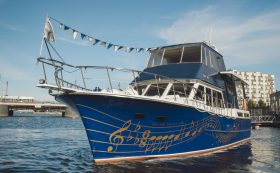
Motor yacht "Discovery"
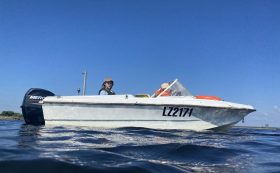
Motorboat trip
Motorboat trips along the Trade Canal, Lake Liepāja, and the Bārta River. If the weather conditions are suitable, it is possible to venture into the open sea. Offer also includes rides on an inflatable tube or wake board behind the boat.
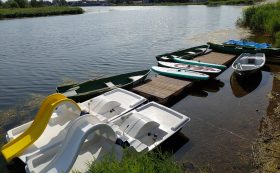
Pedal catamaran, SUP board and boat rental "Kubs"
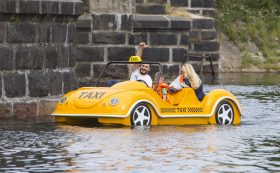
Pedal catamaran, SUP board and boat rental
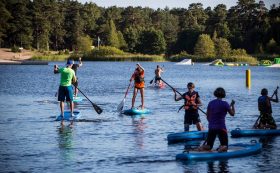
Sailing school
Sailing, windsurfing, SUP board rental and training.
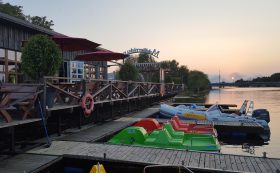
Makšķernieku nams
Boat rental for trips and fishing, pedal catamaran, raft and sauna rental.
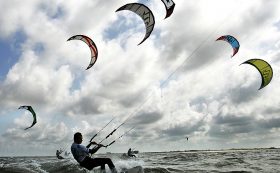
Kitesurfing club "kites.lv"
Kitesurfing promotion, training.
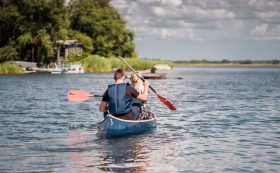
Canoe rental "Atvars laivas"
Paddle into the peace of nature and feel true freedom with “Atvars Laivas” boat rentals. Available: stable, spacious, and comfortable three-person canoes and two-person kayaks for scenic trips along the Fortress Canal, Lake Liepāja, and other beautiful waterways of Kurzeme.
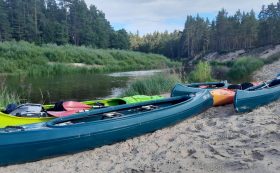
Boat rental "Remo Laivas"
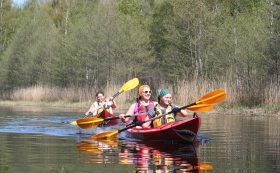
Liepāja Fortress Canal
On the 7 km route, it is possible to enjoy both the diversity of nature and to see the parts of Liepāja Fortress. At the beginning of the route, the black alders along the canal bank are replaced by the dune forest with pines at the canal mouth, the banks are mostly grassy, but the marshy landscape is visible around the area, where the Lake Tosmare borders the fortress. In several places, parts of Liepāja Fortress are located on the islands and on the peninsula, while the fortress part on the left bank of the canal before its mouth, is known today as the Northern Forts.
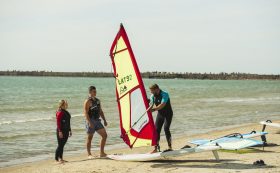
Active leisure centre "Rietumkrasts"
Windsurfing and kitesurfing equipment rental and basic training. SUP board, sea boat, Jet ski rental, as well as tubing.
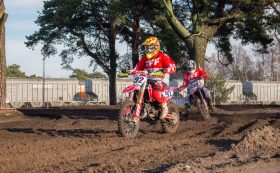
Motocross park "Lauma"
The motocross park was established by former motorcycle racer Lauris Freibergs, a ten-time Latvian and 2000 European champion. After ending his sports career, he turned to training young motorcyclists and promoting motorsports, offering advice and training to anyone interested.

Bow shooting club "Archery Liepāja"
The archery club "Archery Liepāja" invites visitors to explore the archery world under a professional instructor's guidance at a beautiful, well-maintained shooting range on East Fort Island in Liepāja. This is a unique opportunity not only to experience this ancient sport, but also to unwind in a natural, tranquil setting.

Electric bike rental
The city's most popular sights can be explored via Liepāja's bicycle paths, which stretch over 55 km. By going on a bike ride, you’ll have the opportunity to enjoy charming parks, fresh sea air, vast forests, and beautiful landscapes!
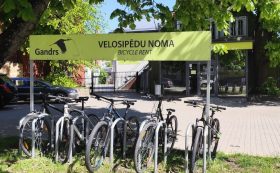
Bicycle and tourism equipment rental "Gandrs"
"Gandrs" offers active recreation equipment for rent, including bicycles (electric ones as well), accessories (child seats, trailers, helmets), tents, sleeping bags, trekking poles, mattresses, and backpacks. Winter sports equipment, such as snowboards, skis, and boots, is also available for rent.

Bicycle rental "Roze Boutique"
Whether for a short ride or an extended journey, rental options are adapted to meet various needs.
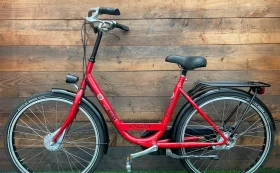
Bicycle rental "VeloMoto"
Velo Moto Veikals, in Liepaja, offers bicycle rental for comfortable city sightseeing.
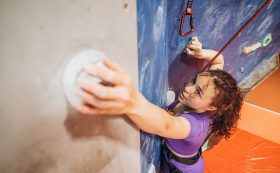
Climbing wall in the LOC Manege
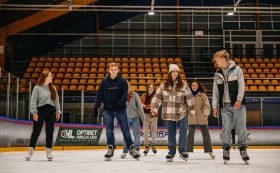
LOC Ice Hall
For skaters, hockey players and spektators.
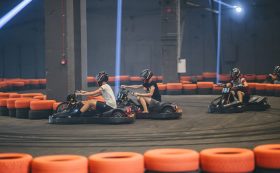
Sports and entertainment center "Drift Arena"
Sports and entertainment center "Drift Arena" offers the chance to try out the Latvian-made drift tricycle "Wolftrike," allowing everyone to experience real drifting in a safe environment. It provides exciting activities for children, young people, families, and colleagues, enabling everyone to enjoy adrenaline-filled moments together. A café is also available at the entertainment center.
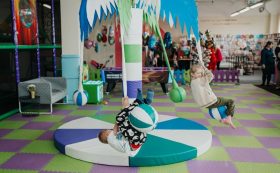
Entertainment centre for children "Sapņu Zeme"
The children’s entertainment centre “Sapņu Zeme” offers trampolines, standard and camera slides, and a separate area for younger visitors with Igloo blocks and a ball pool. The centre can accommodate up to 100 people at a time.

Recreation and Entertaining Centre "Dzintara Boulings"
8 bowling lanes, pool billiards and other attractions, pizzeria – café.
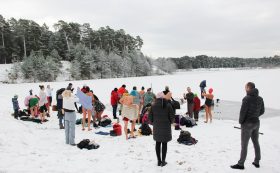
Winter swimming site in Recreational Park Beberliņi
A venue for everyone, whose hobby is winter swimming or "ice-swimming".
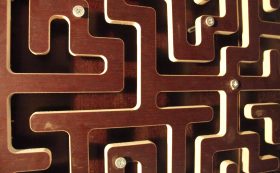
Escape Rooms at Karosta Prison
In Karosta Prison we offer two Escape Rooms:

Spy Game "Escape from the USSR"
Activity for a team (6-10 pers.). The aim is to rescue a friend by working together and make it to the submarine by hiding from border patrol.
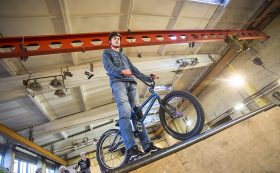
Indoor track "Rave Action Park"
BMX, freestyle, inline, indoor track
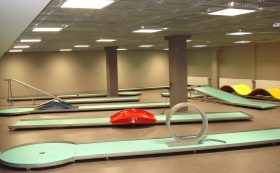
Mini golf
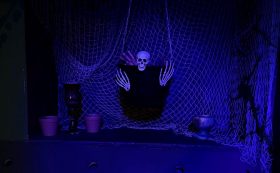
Escape room "Panic Rooms"
The escape rooms "Panic Rooms" offer a themed escape game "Fear Forest", where participants have one hour to escape from three interconnected rooms by solving tasks and puzzles. The game features special effects, horror elements, and live actors, creating a realistic and emotionally charged atmosphere.

Escape room "Exitgame"
People are starting to disappear in the city ... You and your friends have found themselves in the footsteps of a possible culprit, a psychologist Bahilov, who recently arrived in the city ... You secretly enter the doctor's office to find evidence! The game can begin!

The rage room "Hammer and Scream"
The rage room "Hammer and Scream" is specially designed to safely reduce emotional tension in a controlled environment. Visitors can use designated items – such as dishes or discarded electronics – to break them safely and relieve stress without causing harm to themselves or others. This experience serves as an unconventional form of relaxation that helps release tension while offering a fun and engaging way to spend time.

Smash Room Liepāja
Come and smash various things to reduce your tension in a controlled way or just have fun.

Pneumatic shooting range “Lodīte”
Recreational and sports shooting with pistols, rifles and airsoft guns.
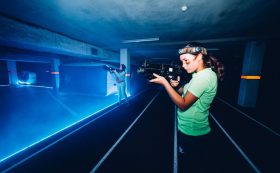
Laser tag arena
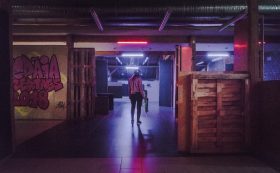
Laser Tag Arena "Wind Poligon Liepāja"
Recreation centre for celebration events. Entertainment devices and the newest laser tag equipment is available. Activities are appropriate for any age group.
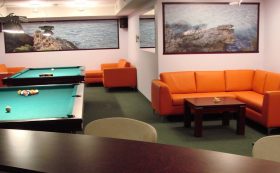
Billiard hall in the hotel "Kolumbs"
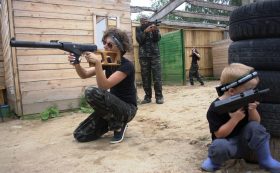
Laser Tag Game "Plan B"
The analogue of Paintball, Laser Tag is a high-tech game, which aims to neutralize opponents with an infrared beam.
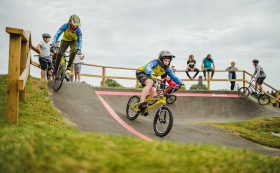
Grobiņa velo track
A modern tarmac pump track has been opened in 2020. The track is multi-functional, suitable for BMX, mountain bike, skateboard, scooter, roller skates, longboard, etc. Its use does not require any special preparedness and it is suitable for users of different ages.
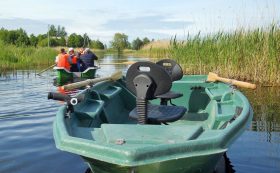
Recreation in Pape
Rent of tourism equipment for the whole year-round fun. Bikes for adults and kids, angler’s boats and water catamaran.
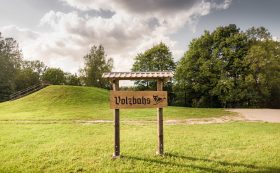
Recreation Place "Volzbahs"
During winter – more than 100 m long downhill ride on skis, snowboard, and a sled. Operating lift in accordance with the weather. During other seasons – a great place to enjoy the scenery and hiking.
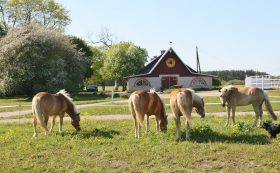
Recreation Complex "Jura staļļi"
Horse-back riding classes, horse-back riding on the field and in the woods, a drive in a two-horse team driven cart or sleigh, availability of specially trained small horses and ponies for children.
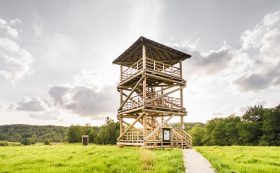
Embūte Nature Park
One of the most beautiful and mysterious places in Kurzeme, a land of tales and legends. Here origins the famous tale about the forbidden love between Indulis, the ruler of the Curonians, and Ārija, German komtur‘s daughter. In the place where they used to see each other now grow the oak trees of Indulis and Ārija.
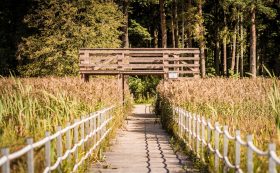
Kazdanga Manor Park
Kazdanga Manor Park covers an area of 196 hectares. There are walking and cycling paths, well-equipped recreation areas, a volleyball and basketball court, a stadium and possibility for renting recreational hiking equipment such as bicycles and catamarans.
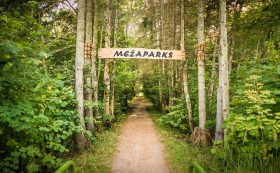
Cīrava Forest Park
The park along the Durbe River has some footpaths with little bridges and benches to sit on. The “Beaver Trail” has several elements for active recreation – rope bridges, climbing walls, swings, etc.
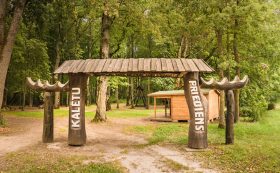
Kalēti Forest Park "Priediens"
The forest park has been created in the former park of Kalēti manor, home to different indigenous tree species and several exotic and rare tree species. Three nature trails with wooden sculptures have been created – mushroom, animal and medicinal herb trails.
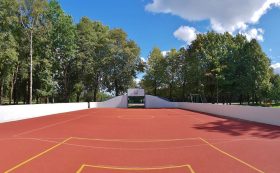
Vaiņode Park
The Vaiņode Park is suitable for both strolls and active leisure. The park is equipped with outdoor training devices, a sports and a children's playgrounds.
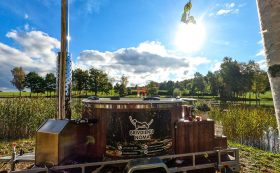
Sauna and hot tub rental "Brīvdienu Noma"
Enjoy a powerful leisure activities at the Durbe Lake riding a jet ski, an inflatable bladder or sofa, or a SUP board.
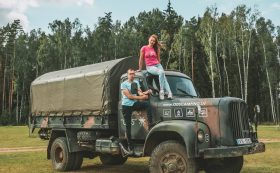
Recreation complex "Ods"
The recreation complex "Ods" on the banks of the Bārta River offers for both, active tourists and quiet nature lovers, to spend their overnight in comfortable houses or celebrate festivities at the guesthouse's party hall or the Festival tent.
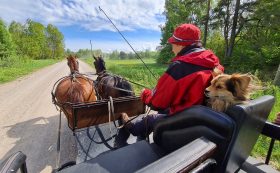
Horseback rides "Stiebriņos"
Riding on horseback and on pony or in a horse cart for competition along the river Virga. Horseback riding lessons, Reittherapy. Educational excursions for groups.
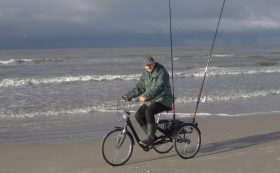
Sea bicycle-fishing
Rental of fishing equipment, rental of specially fitted bicycle for carrying fishing equipment, tour guide services.
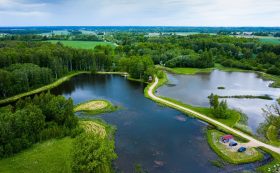
Recreational place "Dižozoli"
Picnic and tent spaces, children playground. Organizing of sports and other events.
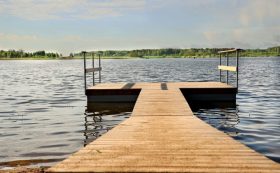
Prūšu Reservoir
Comfortable resting place with a bonfire, grill, tables, chairs and a shed. Children playground, beach volleyball court, barefoot trail.
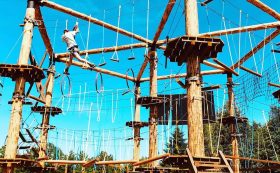
High Ropes course "Cietais rieksts" / "The Hard Nut"
A chance to challenge yourself on courses of different height and difficulty level with both vertical and horizontal obstacles to overcome, in a uniquely constructed tower.
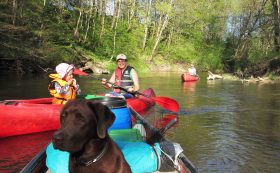
Canoe rental "Redzēt debesis"
Canoe trips in Durbe, Tebra and Rīva. Consulting and transport. 13-seat canoe trips along Saka River.
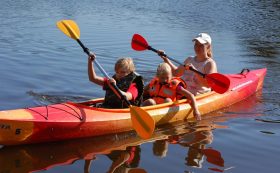
Boat rental "Krastiņu laivu noma"
Canoes and kayak rentals in Liepāja Lake, the Fortress Canal, the Bārta River and other waters of Kurzeme. Delivery of boats and travellers to the starting point of the selected route or pick up at the finish point.
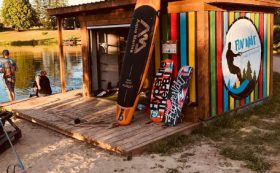
Wakeboarding Park "Fun Wave"
Cable wakeboarding course and SUP board rental.
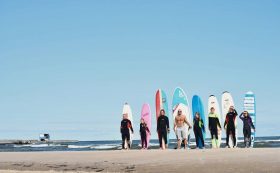
Pāvilosta surf club SERF
Surfing lessons and equipment rental.
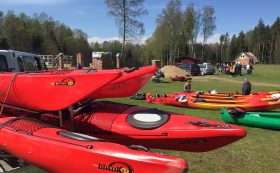
Rental of sea kayaks and inflatable SUP
2 single and 2 tandem sea kayaks, as well as 2 inflatable and easily portable in a backpack “Stroke” SUP boards are available for rent. Vests, polyprene gloves, boots, storage bags and helmets are also provided.
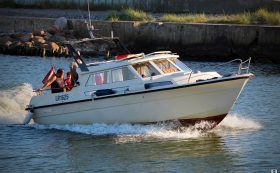
Trips by boat "IZI"
The hour-long ride gives the possibility to get a quick look at the Pāvilosta from an unusual point of view – the Saka River – as well as take out to the sea.
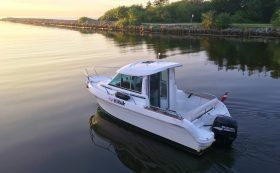
Recreation in Camping "Pāvilosta Marina"
Small ship, motorboat and boat rides.
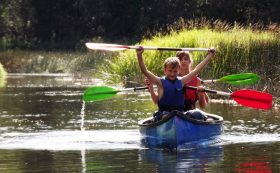
Boat and SUP board rental "Sofijas laivas"
The "Sofijas laivas" company owned by Šēfers family, operates since 2007 and offers canoes and kayak rental in Kurzeme rivers – Bārta, Vārtāja, Rīva, Irbe, Abava, Tebra, Saka, Durbe, Alokste, as well as boating routes in the Lake Pape and Liepāja Fortress Canal.
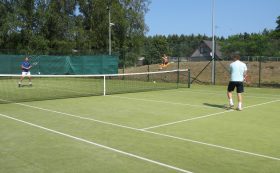
Tennis court in Pāvilosta
Artificial lawn court.
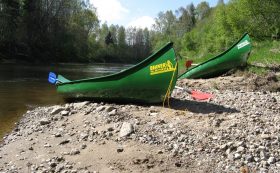
Boat rental "Beaver"
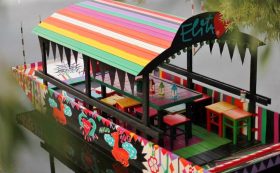
Picnic boats in Bārta River
Rides with the picnic boat "Matilde" and "Elita" on the Bārta River. Each boat suitable for 12 people.

The Beach
Liepāja beach has been a popular swimming area since the 1860s when Liepāja was in the process of becoming a well-known spa resort and place to improve your health among European and Russian aristocrats, one of them being the Russian Tsar himself.

Seaside Park
The 3 kilometres long Seaside Park occupies a territory of 50 ha – currently one of the largest planted parks in Latvia. The park was first established at the end of the 19th century to enhance the area's appearance, planned as a spa resort, and also to prevent sand from being blown into the city by the wind.
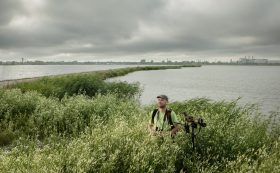
Bird watching in Liepāja
Liepāja sits on a string of land between the Baltic Sea and the lagoon-type Lake Liepāja, formed by the receding sea. Liepāja is well suited for birdwatching almost all year round, and thanks to its mild maritime climate, birdwatchers often find it attractive even in winter.

Bird watching in Liepāja
Liepāja sits on a string of land between the Baltic Sea and the lagoon-type Lake Liepāja, formed by the receding sea. Liepāja is well suited for birdwatching almost all year round, and thanks to its mild maritime climate, birdwatchers often find it attractive even in winter.

Bird watching in Liepāja
Liepāja sits on a string of land between the Baltic Sea and the lagoon-type Lake Liepāja, formed by the receding sea. Liepāja is well suited for birdwatching almost all year round, and thanks to its mild maritime climate, birdwatchers often find it attractive even in winter.

Bird watching in Liepāja
Liepāja sits on a string of land between the Baltic Sea and the lagoon-type Lake Liepāja, formed by the receding sea. Liepāja is well suited for birdwatching almost all year round, and thanks to its mild maritime climate, birdwatchers often find it attractive even in winter.
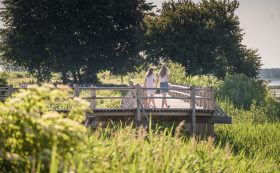
Zirgu Island Nature Trail
A 4 km long walking trail with wooden footbridges, a birdwatching tower and two viewing platforms over the lake Liepāja.
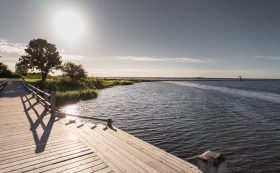
Lake Liepāja
Lake Liepāja is a lagoon created by the receding Baltic Sea. The lake and surrounding meadows are included in the nature reserve "Liepājas Ezers" and is a "Natura 2000" protected area of European significance because of nesting and migratory birds that can be found there. Included in the list of protected bird species are 27 nesting bird species, 10 winter bird species and 50 bird species that feed here during migration.

Nature House
The Nature House is an environmental educational centre where visitors have the opportunity to learn about environmental sciences – biology, ecology, zoology and other fields of natural science. With pre-application, the Centre is open to all interested parties, and particularly welcomes school groups and families with children.
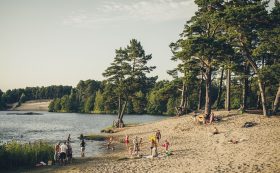
Beberliņi recreational park
Beberliņi recreational park spans a 45,3 ha-wide area in Karosta. The main nature value of this site is the pine forest developed on the sand dunes, which is a protected habitat area. The forest encircles an 8,8 ha large water body of Beberliņi, which was formed artificially, extracting sand for the construction of military sites.
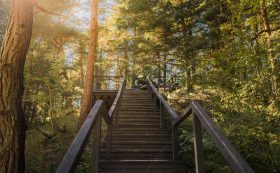
Nature Park "Bernāti"
Park has the status of a European protected nature area Natura 2000. Seashore with fine, white sand, dunes and pine forest attracts visitors during the winter to enjoy walking through the forest trails, to sweep down the hill with sleigh or to ski through the forested dune trails and paths. In summer one can enjoy sunbathing on the wide beach and swimming in the sea.
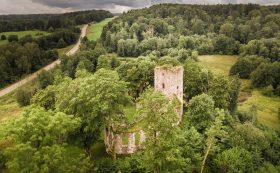
Embūte Nature Park
Embūte old valley is one of the most scenic, interesting and enigmatic places in Kurzeme. Over the course of time a good many legends and tales have been gathered which relate to Embūte. Embūte is one of the oldest populated places in Kurzeme, established approximately 10 000 years ago when the glacier was receding. For centuries it was a sacred place. Already in the 13th century Embūte was an important place. This can be judged by the fact that it was not only the scene of battles, but also a bishop’s castle and a cloister was built there.
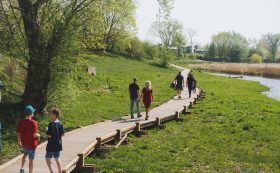
Footpath along the Ālande River
A walking path of 3 km runs along the curvy banks of the River Ālande, through the town of Grobiņa, connecting several monuments of the Grobiņa Archaeological Ensemble, such as a medieval castle with bastions, Hornbeam Hill and the Old burial ground “Priediens”. There are stands along the whole length of the path, where stories significant to the history of Grobiņa can be found.
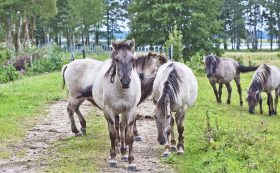
Pastures of wild horses and aurochs in Nature Park "Pape"
In 1999 the first wild horses in Latvia were brought to the meadows to the east of the Pape Lake. Feeding on grass, bushes, reed and bark, the animals ensure the preservation of meadow, coastal habitats and agricultural lands thus enlarging the biodiversity of the territory, as well as the preservation of the landscape of the park. In 2004 the first Auroxen Cows were introduced here.
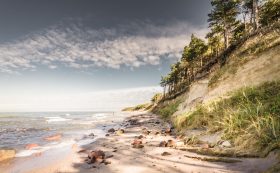
Steep coasts
The coasts stretch across tens of kilometres. In Ziemupe the coasts height is between 5–12 m, while in Strante–Ulmale it reaches up to 16 m.
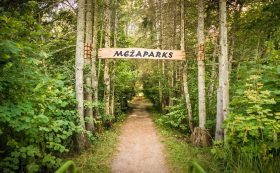
Cīrava Forest Park
The park along the Durbe River has some footpaths with little bridges and benches to sit on. The “Beaver Trail” has several elements for active recreation – rope bridges, climbing walls, swings, etc.
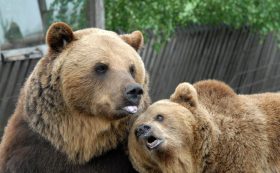
Rīga Zoo branch "Cīruļi"
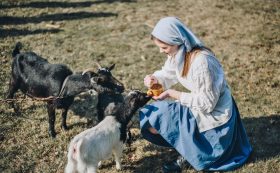
Mini Zoo "Atomi"
In the Mini Zoo, there is an opportunity to look at and find more about Indian and White peacocks, turkeys, Silkies or silk chickens and Indian Runner ducks. There are also living African ostriches Ancis and Kleo, the Australian emu bird, the mongoose Emma, the donkey girl Žuža, the lamas Centis and Bella, Dutch Dwarf goats and a pair of Red deer. In the pastures, you will also see cows, sheep, and wild horses.
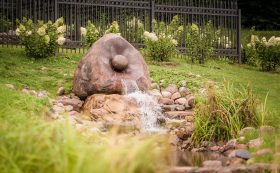
Lielbāta Spring
Lielbāta Spring is the largest clear spring in Latvia. It is located on the Western Kurzeme highland close to the historic Vaiņode or Lielbāta Castle. Lielbāta Spring’s water source flows from west to east towards the sun – because of that already in the ancient days it was considered magical, even sacred, and was attributed healing properties.
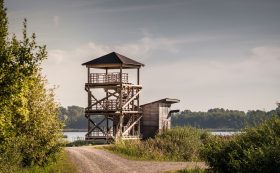
Lake Durbe
Durbe Lake is one of the biggest lakes in Liepāja region with beautiful scenery. It has a surface area of 670,5 ha with the avarage depth of 1,5 m. Lake’s north-east territory’s alluvial land meadows are included in the protected area register of Natura 2000.

Kalēti Forest Park "Priediens"
The forest park has been created in the former park of Kalēti manor, home to different indigenous tree species and several exotic and rare tree species. Three nature trails with wooden sculptures have been created – mushroom, animal and medicinal herb trails.
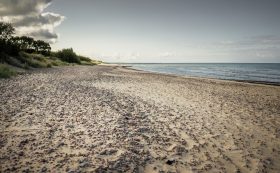
Nida pebble beach
To Latvia uncharacteristic pebble shore.
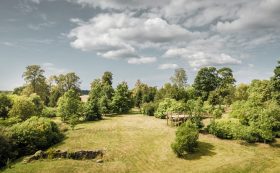
Rucava arboretum
A dendrological garden with exotic trees and a recreational area with a viewing platform, affording a beautiful view of neighbouring Lithuania, has been set up on the Manor Hill. From the Manor Hill it is possible to continue the walk to the Latvian-Lithuanian border river Sventāja. Magnolia plantings can be seen in the centre of Rucava, but in the school garden, there is a collection of rhododendrons, as well as a large variety of yew trees.
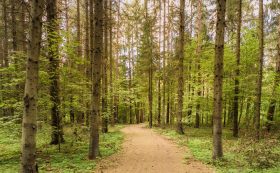
Gramzda forest park
2km-long walking trails, “Green Classroom” and an outdoors cinema “Nature Inspires”. The park territory also has a bike trail.
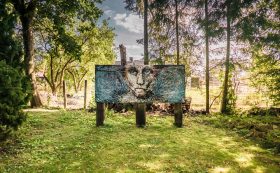
Ģirts Brumsons’ Park of Art
A nature park with a collection of rare plants and the artwork and small architectural forms made by Ģirts Brumsons.
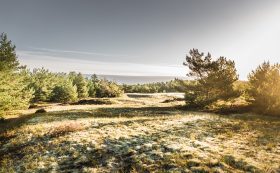
Grey dune of Pāvilosta
The largest and one of the most varied grey dunes in Latvia. Grey dune of Pāvilosta spread to the north from the Saka river mouth within the length of 1.5 km and their width reaches even 812 m in some places. It is specially protected habitat in Latvia and is included in the list of EU protected biotopes. The Nature Reserve "Grey dune of Pāvilosta" was established to provide the protection of specially protected biotopes – a grey dune covered by caulescent plants, grey dunes with shrubbery stands, woody seaside dunes, dry heath of sand plains of the coastal lowland and the protection of the specially protected species living there.
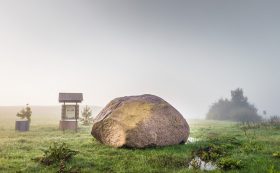
"Odziņu" Cup-Marked Stone
Ancient cult stone dating back to the Bronze Age, the Odziņu boulder 2000-3000 years ago was used as a shrine. During the cultivation of agricultural land the stone was unearthed. In 2013 the stone was dug out and moved to a new location not far from the Mātra hill fort. Now a boulder the size of about 15 cubic meters and weighing 43 tons once again is open for inspection at a new location near the Grobiņa-Ventspils highway.

Aizvīķi Park
Aizvīķi Manor Park was developed at the end of the 19th century. Here you can see wooden sculptures of the heroes from fairy tales and legends about the history of Aizvīķi. The park is full of quite many exotic tree species unusual for Latvia’s climate – the hickory tree, cork tree, nut tree and others.
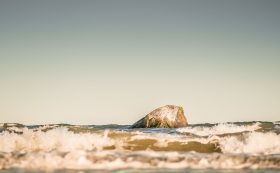
Pāvilosta Great Boulder
Pāvilosta Great Boulder or Sea Boulder is washed by the waves in the sea about 50 m from the coast. Its height above the ground level is 3,5 m, perimeter - 15 m. During Soviet times the stone marked the border people were not allowed to go further along the sea coast.

Cīrava Rhododendron garden

Herd of goats at the organic farm "Baroni"
Visits by prior arrangement!
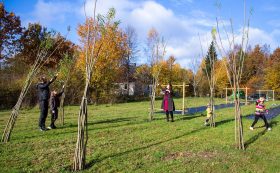
Furniture orchard "Forest Designed"
"Forest Designed" is the first "nursery" of furniture in Latvia. Its formation began in the summer of 2020, and the official opening is scheduled for the second half of 2021. Nevertheless, already today, by prior request, the owners are happy to welcome guests, show the process of creating a garden, the nursery plants of the first furniture, and offer the opportunity to have a picnic by the fire in the woods.
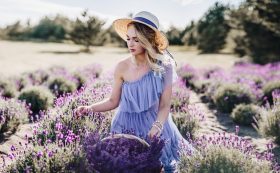
Lavender Farm "LavenderVilla""
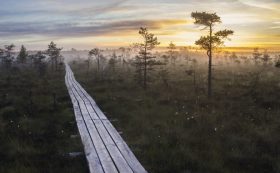
Dunika Swamp Trail
This 5,5 km long walking trail is laid out with wooden planks stretching right over Tīrpurvs as far as the almost 150 year old Lukna hornbeam grove rising its branches to the height of a six-storey house.

Nature in the Dienvidkurzeme Region
Nature in the Dienvidkurzeme region is both powerful and serene – a coastline of ever-changing shores, coastal bluffs and beaches, lush forests, winding rivers and valleys, lakes, fields, and meadows, all interwoven with nature parks and protected areas. Here, you can explore unspoiled landscapes where trails lead through wetlands, woodlands, and historic sites, while the sea breeze and silence offer a sense of calm. Learn more about hiking routes and nature trails here.

Karosta
Karosta is a wondrous, paradoxical and unique place not only in the context of Latvia, but also in the historical and architectural context of the world. Karosta is the largest historical military garrison in the Baltics and constitutes almost a third of Liepāja’s territory.




















































































































































































































